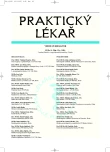Insulin pump therapy for diabetic patients
Authors:
R. Kožnarová
Authors‘ workplace:
Ředitel: MUDr. Štefan Vítko, CSc.
; Institut klinické a experimentální medicíny, Praha
; Přednosta: Doc. MUDr. František SAUDEK, DrSc.
; Klinika diabetologie
; Přednosta: prof. MUDr. Terezie Pelikánová, DrSc.
; Centrum diabetologie
Published in:
Prakt. Lék. 2007; 87(2): 73-76
Category:
Reviews
Overview
Diabetes control through subcutaneous insulin infusion (CSII) is currently the therapeutic option that most closely mimics physiologic insulin secretion and provides for glycemia levels close to normal even where standard injection insulin therapy fails. Following CSII installation, the mean daily dose of insulin usually decreases and diabetes control improves (HBA1c falls). Most patients have the CSII installed because of poor diabetes control. The most frequent indications are the “dawn phenomenon”, severe hypoglycemia, and progression of diabetic complications.
Key words:
Diabetes mellitus, continuous subcutaneous insulin infusion (CSII), insulin pump.
Labels
General practitioner for children and adolescents General practitioner for adultsArticle was published in
General Practitioner

2007 Issue 2
Most read in this issue
- Risk of malnutrition and nutritional support in Alzheimer disease
- Active search for prostate cancer by PSA testing in GP surgery
- The legacy of I. F. Semmelweis; key milestones in the development of hospital hygiene and current challenges.
- Symptomatic diabetic neuropathy: irreversible nerve damage?
